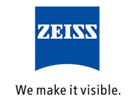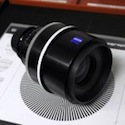NAB Recap pt. 1: Cameras and Lenses
Apologies for the recent radio silence! Following the week at NAB I have been on the road from San Francisco, to New York, to Chicago, to Boston, and finally back again.
That being said, I didn’t want to let NAB 2012 pass without mentioning a few of the products I saw there this year that stood out. In the list below you will find some new cameras and lenses. Expect a follow up post in 48 hours or so that will cover support accessories we saw at NAB. I have tried to highlight items that caught my eye and bring new features to the table in both the HDSLR market as well as the cine market.
 |
Black Magic Cinema Camera | B&H | Mfr. Site | |
|---|---|---|---|---|
|
The Black Magic Cinema Camera was acquiring quite a bit of buzz on the show room floor at NAB this year. The camera has a 2.5K sensor and shoots a 2.5K RAW image, or a 1080p image in ProRes or DNxHD. The camera also has a huge built in LCD touchscreen on the back and is compatible with either EF or ZE lenses. And the cost? $3000 US. Which is an excellent price point for the ability to acquire a RAW image and considering that Davinci Resolve and UltraScope software (about $1,600 of software) are included for free with the camera. I look forward to seeing this camera in action and what images it produces. |
||||
 |
 |
Zeiss CZ.2 70-200mm | Mfr. Site | |
|---|---|---|---|---|
|
Like the CP.2’s this lens has interchangeable mounts, from PL to EF, and is intended to be a Zoom companion to the compact prime set. It is encased with cinema style lens gearings and hard stops so that it works like a cinema lens lens. Unlike its photographic counterpart (the Canon 70-200mm f/2.8), this lens opens to a T/2.9 – which is pretty much identical (T stop measures tend to be more accurate than f-stop FYI.) This lens is available sometime in Q4 of this year. |
||||
 |
 |
Zeiss CP.2 Super Speeds | Mfr. Site | |
|---|---|---|---|---|
|
In addition to showing off its new zoom lens, the CP.2 line also added three new super sped lenses to its lineup. The lenses open to an aperture of T1.5, which give you almost two more stops of light from the T/2.1 apertures on the original CP.2 lenses. The super speeds will be available in focal lengths of 35mm, 50mm, and 85mm. These are extremely exciting lenses as you now can shoot in very low light with what is still one of the highest quality yet affordable cine lenses in the market… Ultra Primes and Master Primes have been around for awhile but are significantly more expensive (and of course perform at the highest level – that you probably don’t need unless you are projecting on a 30+ foot screen.) |
||||
 |
 |
Zeiss CP.2 additions: 15mm and 135mm | Mfr. Site | |
|---|---|---|---|---|
|
The CP.2 line also has expanded its range of focal lengths, adding a 15mm T/2.9 and a 135mm T/2.1. At T/2.9 – the 15mm is much faster than the 18mm T/3.6. It is also impressive that the 135 maintains the common aperture of T/2.1 that most of the CP.2’s share in common. It is great to get an even wider range of focal lengths in this already great set of lenses. The CP.2 lenses continue to be a smart long term investment given that they can be used on both PL and EF cameras. If and when you move to the more expensive cine lenses (that sell in the $8K-20K per lens range!) you can still use the CP lenses on your B camera. |
||||
 |
 |
Zeiss Anamorphic Lenses | Mfr. Site | |
|---|---|---|---|---|
|
Zeiss had its prototype anamorphic lenses on display at NAB. The particular lens they were showing was a 50mm T/1.3. However no focal lengths or apertures have been set for the entire range of lenses. The only thing that is certain is that these lenses will have a 2:1 squeeze and be priced significantly higher than the Zeiss CP.2’s, between $20k and $30k per lens. This puts these lenses in league with Zeiss and other high level cinema lenses. I sure can’t wait to play with these!!! |
||||
 |
Schneider Cine-Xenar III Lenses (18, 25, 35, 50, 75, 95) | Mfr. Site | ||
|---|---|---|---|---|
|
I was fortunate enough to get to try the II series of these lenses last year and was extremely impressed with the optic quality, but was disappointed by the fact that the lenses did not maintain a constant volume when focused. The front element of the lens telescoped, increasing the length of the lens depending no the focus distance, which made these lenses incredibly difficult to use with a matte box. However, Schneider has re-engineered the lenses to hold constant volume while focusing and has added an 18mm to the original 25, 35, 50, 75, and 95mm. These lenses are all manufactured to be the same size, so that switching lenses is easy and requires no changing of position for your follow focus or any other accessories for that matter. Looking forward to getting my hands on these as well. The new lenses are also smaller and lighter than the previous generation – very similar to the Cookes in size. These are supposed to live right in the middle of the Zeiss CP.2 and Cooke series in terms of contrast. |
||||













Thanks for the recap.
I don’t know if I’d say “Unlike its photographic counterpart (the Canon 70-200mm f/2.8)” as it probably is f2.8 as well, only measured and rated at T2.9.
Vincent Laforet Reply:
May 8th, 2012 at 2:46 pm
What I meant is the difference between 2.8 and 2.9 is almost impossible to distinguish – and that 2.8 w/ still lenses isn’t as strictly regulated at T2.8 w/ cinema lenses (those standards are much more strict.)
Hi Vincent,
Thanks very much for the post.
About the BM camera, I have a question, maybe a silly one:
How we are suppose to shoot without wide angle? If the sensor is less then 4/3, well, A 21mm shot would impractical, wouldn’t it? I mean, extra wide / fisheye wides are not as good as normal or wides (like Zeiss or Leica r). So we would have to give up lens quality in exchange for wide angles? Or carry a second camera on the side? Hmmm… Any thoughts on that?
Vincent Laforet Reply:
May 8th, 2012 at 2:44 pm
That’s the inherent problem with 4/3 sensors – getting wide shots is always an issue. You can do it – but it usually involves expensive glass. The BM camera seems like a nice “16mm” esque camera perhaps… easy, small, light…
Nice roundup brother. The Black Magic looks really interesting, not to mention that back on your post about the IKONOSKOP 16mm in Sept. I stated the rhetorical question as to why cinema camera makers didn’t adopt a standardized media format such as SSDs and here you have a camera that does just that, and accepts all of my Canon EF glass to boot. Can’t wait to rent one and a see how it performs.
I played with the BM camera quite a bit and it looked interesting. If it just had an interchangeable battery. The pricing is great for what you get, though. Another trend in cinema glass I noticed was lenses with ENG style servos…
http://www.abelcine.com/store/Fujinon-ZK4.7X19-19-90mm-T2.9-Cabrio-Compact-Cinema-Zoom/
Angenieux is also making a strap on version for their Optimo lenses. Great for run & gun, doc shooting.
For anyone interested here is some test footage of the Black Magic Design camera in action by Australian Cinematographer John Brawley.
http: //youtu.be/M7R3eulAWcE
I spoke with BMD and they told me that third party suppliers would be addressing the internal battery issue when it is released in July. I look forward to this camera when it does arrive.
The BMD battery issue can be resolved w an extensive choice of external pro batteries attached via the charger port, no? Almost all pro cameras use external bricks anyway.
@Matt Short, you don’t have any problem with the battery you could use a baseplate adapter with an anton bauer camera using the AC adaptor… That has never been an issue with cameras… Im really looking forward for this camera… I’ve shot a film with a SI2K it has a 2/3 sensor and produces astonishing images… I suppose as always, it’s not the camera, but the guy that holds it.
My biggest question about the BMD Cinema, and I would appreciate Vincent’s input on this, is that the access to the rear LCD touch screen is obviously very critical. I can not for the life of me figure out how I would build a rig that can hold the camera, matte box, follow focus, battery system, wireless video transmitter and wireless audio in a way that is effective for making it able to quick swap between a tripod, hand held, jib, steadi-cam.
Thanks Vincent,
Do you know when the CP.2 super speeds will be available? Will they be adding other focal lengths to the super speed set?
Vincent Laforet Reply:
May 29th, 2012 at 7:55 pm
135mm and 70~200 as well as the 15mm are coming… not sure on release dates yet!
Do you know where we could purchase the cinema camera online? All vendors seem to have a preorder option. This video helps show the quality and design of the new product, very helpful. http://www.avalive.com/Blackmagic-Design/CINECAM26KEF/167240/productDetail.php